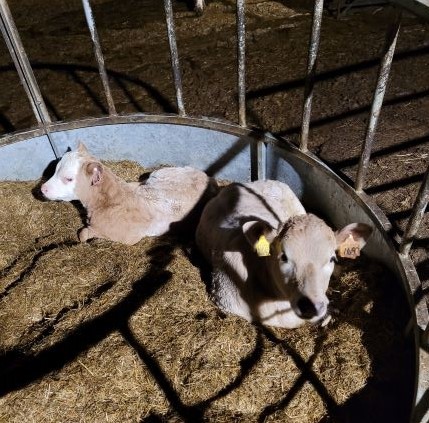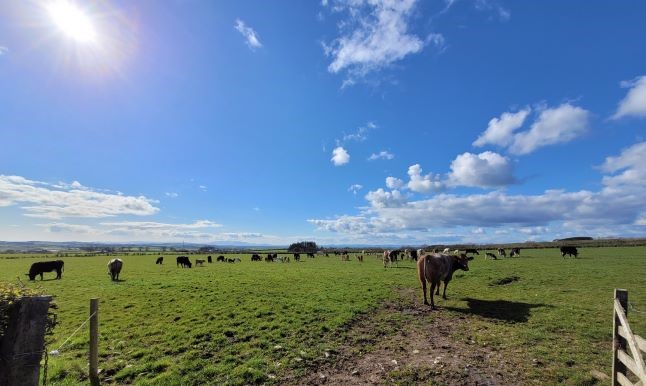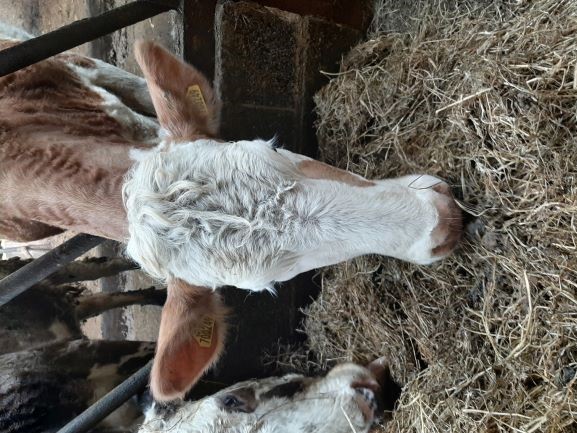Find funding
There are many other organisations who may be offering funding that will help you, and our handy funding search tool brings them all together.
Hi everyone! I can officially say this will be my last blog for a while as maternity leave is coming ever closer and I will be off to have a baby…exciting and scary times!
Over the past month or so things have started to get busy again as calving is now in full swing. All 20 of our heifers (first time calvers) have all calved, are doing well and we are now onto the cows. We have a pen filling up of young calves who are full of fun and energy and quite a bit of cheek too. They regularly like to play races around the pen and up the feed passage, which is a good giggle to watch.

When calving is in full swing there is plenty other jobs to keep us busy, and that’s not just to do with making sure the cows and calves are healthy and fed.
One of those jobs is to tag the calves with two matching tags in each ear, which will be their official identifier for life. This information is then sent off to Scot EID, who then send us passports for each animal. The passport will have all vital information about the animal including ear tag number, mother’s ear tag number, date of birth, breed and place of birth and will stay with the animal for the rest of its life. This is for tractability purposes, in case of serious disease outbreaks, like that of Foot and Mouth in 2001, and allows all cattle movements to be traced.
At this stage we also take a tissue sample – it is the same procedure as putting in ear tags, very much like us having our ears pierced. The sample is sent off to the lab to test for Bovine Viral Diarrhoea (BVD), which is a disease that can have grave consequences if not found and can spread around the herd quite quickly. Any animals who are positive for BVD sadly need to be culled, in order to keep the rest of the herd safe. This is because any animal affected by BVD become very ill, lose weight and have severe breathing problems to name but a few.
We are working hard to make sure all our cattle are safe, and this includes making sure any new members of the herd are tested beforehand too. We have managed to be BVD clear for around 6 years now.
The summer is coming…

With spring time already here, as always, we need to start thinking ahead to summer and even next winter as we prepare the ground for the cows going out to grass and growing our silage. This can be tricky as we fight against the lovely wet Scottish weather. This is the time of year when you will be going for a lovely sunny drive in the countryside and smell that beautiful country air……slurry! Farmers across the country will be using all opportunities of dry weather to put out the slurry they have stored over the winter. If you wake up to a hard, crisp, frosty morning, you can guarantee there will be a farmer somewhere getting the slurry out on the ground. This can also be a bit of a challenging time, as the ground needs to be dry enough to support the machinery. This is also a very smelly time, I do admit, but it is also vital as slurry is full of nutrition. This nutrition supports soil health and grass growth which is so important to ensure there is ample grass for the cows to graze throughout the summer and for the farmer to cut to make hay, haylage or silage for feeding during the winter months.
Over the past few years, it has become less smelly and this is due to a further understanding around climate change and many farmers are now using more up to date kit to spread slurry. Instead of seeing it being pumped through the air out of a huge tank, it now involves a more direct approach where a trailing shoe (which injects the slurry straight into the ground, directly to the root of the grass) or a dribble bar (which lays the slurry on the ground through many small pipes out the back of the tanker) may be used. This is to try and prevent as much of the gasses from the slurry escaping into the atmosphere as possible.
Although, this is easier said than done, this type of kit even when bought second hand does not come cheap. A trailing shoe can cost upwards of £3000 and a dribble bar can cost upwards of £4,500 and this is second hand. Because of this many farmers are either stuck with their older machinery, or have to employ a contractor to do the work for them to try and reduce costs.
The other thing which is applied to the fields is fertiliser. This comes either in solid or liquid form and is applied preferably with the understanding of what nutrition the soil needs – this is found out by doing soil sampling. Soil sampling allows the farmer to understand specifically what support the ground needs to grow good nutritional grass, in turn providing beneficial fodder which supports the cows through the winter.

Fertiliser prices are at an all-time high, which again is posing great pressure on farmers. This is all down to EU exit as well as the pandemic. Last year we spent in the region of £9000 on fertiliser, which is always a big outlay, but it is needed. This year we had to order our fertiliser in advance as we knew the prices were rising rapidly. Even then we paid £16,000 and if we had left it to the same time as we normally do it would have been even more!
Fuel prices are another struggle which people across the country, including farmers are having to face currently. As we are an agricultural business, we use red diesel to fuel our machinery and the prices, I am sure, will be seriously crippling many. In ‘normal’ times it would be around 60p per litre but currently it is sitting at £1.40 per litre! The scary thing is I can imagine that some will be making tough decisions on how they work their farm now, weighing up how to still manage living costs. All of this is such a harsh reality that we are all facing, on the back of that it is now even more important to try where you can to shop local.
Fortunately in Scotland the government provide subsidies and grants which help with the overall cost of everything. To be able to apply for any grants we submit our yearly SAF or Single Application Form. This payment for many, including us, is a life line and it also opens many doors for other grants which in turn can help how well the business is run, including how eco-friendly we can be, just like the Agri-environment Climate scheme (AECS) I previously spoke about in my last blog.
Alongside all the other work we have also been doing some fencing around the farm, again a large expense but we need to keep the cows in the field somehow and the calves were enjoying being free range a bit too much last year! Before we came here this farm was owned by a lovely family who ran a milking farm. They had fewer cows than we do but they also worked very hard. It was a family business, but sadly it became all a bit much. We are so very grateful in many ways that we have found this place. They were one of Gavin’s customers through his work, that’s how we found out about the farm coming up for sale. They have also moved in to the cottage next door, meaning they stay in touch and are able to see the changes we make and how we run the farm as a beef farm and not a milking farm.
There are many differences with the type of livestock farming you do, to name a few beef, sheep or milking. All have different routines and ways, but regardless of the type of farming life chosen, it is chosen through a passion. Farmers choose this life as it is a lifestyle, a way of living but most of all for the love of working with animals. The animals are part of us, they are the first ones we speak to in the morning and the last ones to be checked before bed. If they’re ill, we do our upmost to make sure they have the treatment they need, if they’re calving they are checked regularly or even watched over cctv to make sure they are settled and everything runs well. They are our livelihood, and even the thought of them all going down the road to be sold (which has been a serious consideration in the past due to certain circumstances) breaks your heart! They are our joy, and seeing them happy makes us know we are doing our job right.

The best time of year is when the girls are let back out to grass. Kicking their heels in the air across the lush green grass in the sun, what could be better? What could be a better way to spend your days, or a better life to bring up your children?
And on that note, I suppose I better say bye. I’m now 36 weeks pregnant and could not be more excited to meet our baby girl.
See you all on the other side, and thanks again for reading!
There are many other organisations who may be offering funding that will help you, and our handy funding search tool brings them all together.